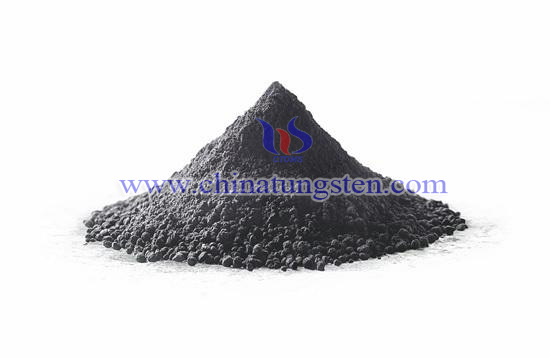Recycling Tungsten Carbide Fiber from Waste Tungsten
- Details
- Category: Tungsten Information
- Published on Monday, 02 July 2018 17:36
Tungsten carbide is black hexagonal crystal which has metallic luster, the hardness is closer to diamond. Since 1973, Levy R B firstly brought up the idea of catalytic effect of tungsten carbide like Pt, researchers started using it in multiphase catalytic and electro catalytic field to take place of precious metal catalyst.
Traditional tungsten carbide synthesis usually uses carbonization reduction two steps method: Produce tungsten powder from tungsten containing precursor, and then tungsten carbide and carbon black are mixed and carbonized at a high temperature of 1400-1600℃ to obtain a tungsten carbide powder. However, in contrast, tungsten carbide particles obtained by this method are large, have a small specific surface area, and low catalytic activity, are not suitable as catalytic materials.
Some scholars have proposed a method for preparing micro-nano tungsten carbide fibers by using waste tungsten. The tungsten carbide fiber diameter of the prepared product is micro-nanometer, and the specific surface area is large. Moreover, using waste tungsten as a raw material, the production cost is greatly reduced, and the recycling of waste tungsten is promoted while obtaining better economic benefits.

1. Waste tungsten is taken from tungsten leaching slag. The main components were determined to be 2.8% WO3, 23.6% Fe, 14% Mn and 2.4% CaO. 500 g of the tungsten leaching residue was calcined at 600 °C for 8h. The calcined material was cooled, pulverized, and passed through a 60 mesh sieve. Subsequently, it was leached with 20% (by mass fraction) of ammonia water, the leaching temperature was 78 ° C, and the tungsten oxide leached therein was completely dissolved for 8 hours. Filtration, taking the filtrate to evaporate and concentrate, adjusting the pH value to 6, the temperature was lowered to 10°C, and the temperature was kept for 4 hours to obtain an ammonium paratungstate crystal. Ammonium paratungstate crystals were heated for 4h at a heating temperature of 230 °C. Deionized water was then added to leaching the hot dissociation product to a liquid to solid ratio of 10:1. Boil at 80 ° C for 6 h under agitation, keeping the pH of the solution at 3.0 throughout the process. The liquid to be cooled is cooled and clarified to obtain a transparent supernatant, which is then filtered to remove insoluble slag to obtain an aqueous solution of ammonium metatungstate. The ammonium metatungstate aqueous solution is concentrated and crystallized, filtered and dried to obtain an ammonium metatungstate solid.
2. Mix 8 mg of polyacrylonitrile (PAN) powder (molecular weight 23000) with 10ml of N,N-methylformamide (DMF, analytical grade), sealed and placed on a magnetic stirrer at room temperature until the solution became homogeneous and transparent. The polymer is fully dissolved in the organic solvent. About 4ml of the prepared polyacrylonitrile solution was poured into a plastic syringe and fitted with a metal needle having an inner diameter of 0.45 nm. The spinning was performed at a voltage of 15 kV and the nano-sheet collecting device was used to receive the nano-polyacrylonitrile fibrils. Micronano-polyacrylonitrile fibrils have a diameter of 100 to 460 nm.
3. The above polyacrylonitrile fibrils are heated to 220° C. and incubated for 30 minutes to complete the preoxidation process.
4. 345 mg of ammonium metatungstate solid (content of WO3 is 85%) is dissolved in 10 ml of water to prepare ammonium metatungstate aqueous solution. The pre-oxidized micronano-acrylic nitrile fibers in step (3) were immersed in ammonium metatungstate aqueous solution until all the template is wetted by ammonium metatungstate aqueous solution to prepare ammonium metatungstate/micronanopolyacrylonitrile. Fibrous primary composite fibers, followed by air drying for 24 hours.
5. The ammonium metatungstate/micronano-polyacrylonitrile fibrillated primary composite fibers were carbonized in a reduction furnace in which a mixed gas of H2 and C2H2 was introduced, and the carbonization temperature was raised to 750°C at a heating rate of 5°C/min, and kept warm. In 2 hours, micro-nano-tungsten carbide fibers are prepared.
After testing, the prepared tungsten carbide fiber has a micro-nano size and a large specific surface area, which is similar to the catalytic behavior of platinum on hydrogen and oxygen, and can catalyze the synthesis gas reaction such as hydrogenation, alkane hydrogenolysis and reforming. At the same time, the micro-nano-tungsten carbide fiber has high electrochemical activity, good catalytic effect, acid resistance, high temperature resistance and anti-CO poisoning in low temperature acidic media, and exhibits excellent catalytic oxidation performance for hydrogen, water, and methanol oxidation. Therefore, micro-nano-tungsten carbide fibers are expected to replace precious metal catalysts in the fields of heterogeneous catalysis and electrocatalysis.
- Tungsten Powder Manufacturer & Supplier, Chinatungsten Online: tungsten-powder.com
- Tungsten News & Prices of China Tungsten Industry Association: www.ctia.com.cn
- Molybdenum News & Price: news.molybdenum.com.cn
- Tel.: 86 592 5129696; Fax: 86 592 5129797; Email: sales@chinatungsten.com



 sales@chinatungsten.com
sales@chinatungsten.com